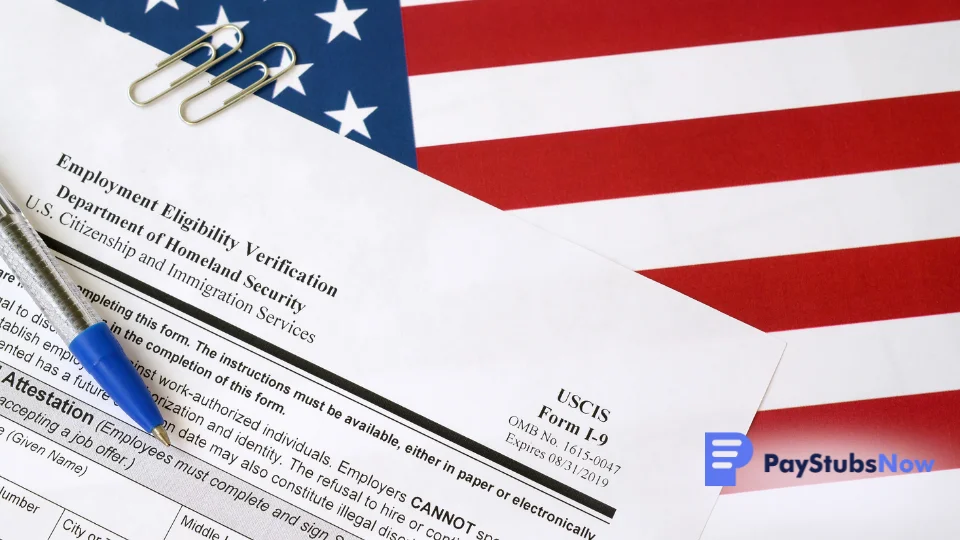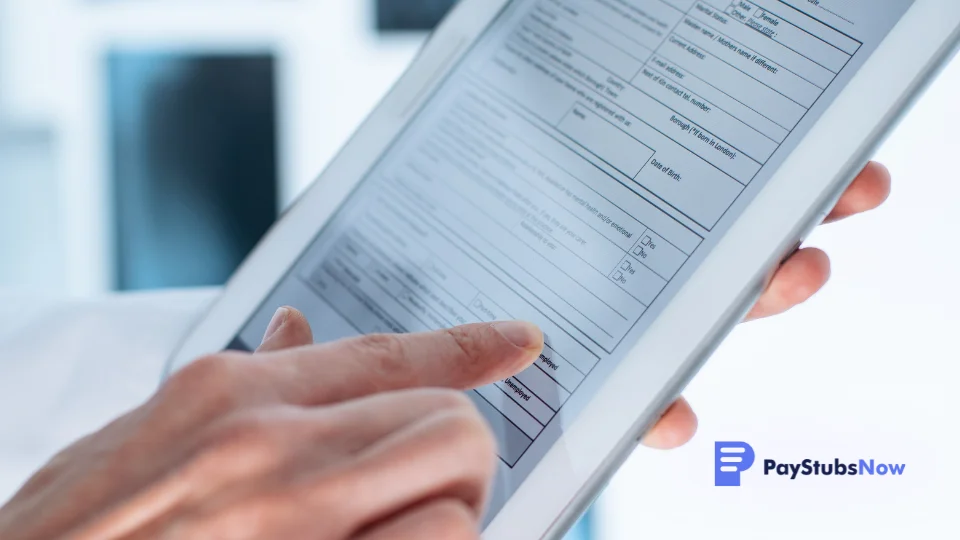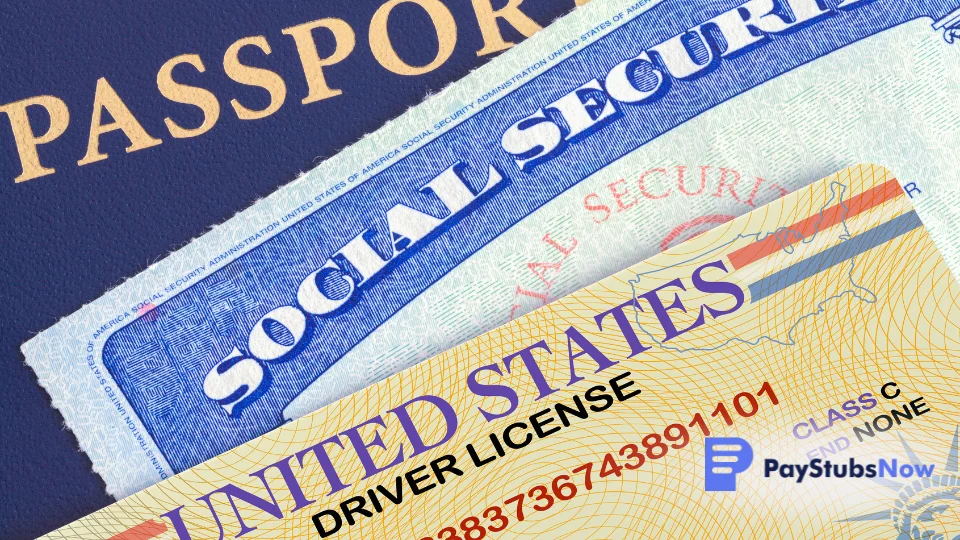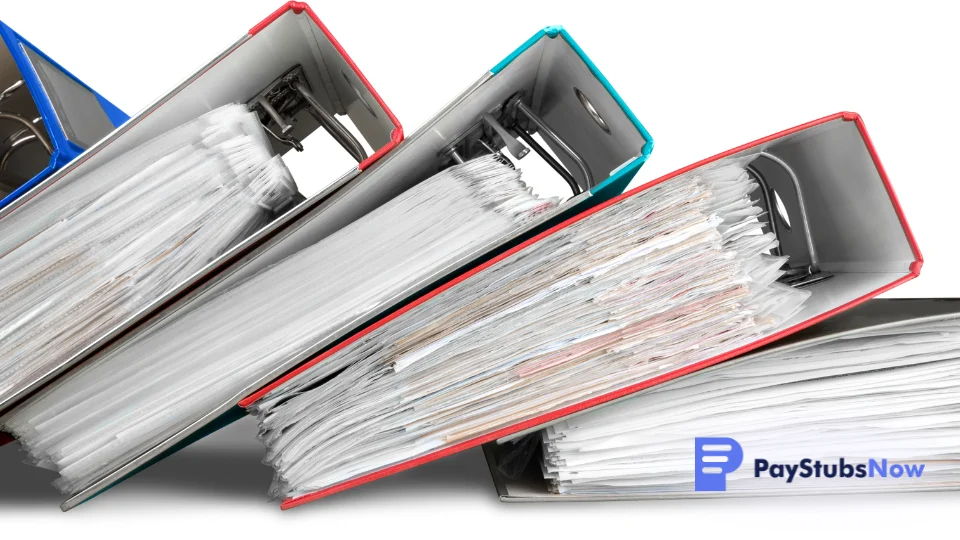What Is an I9? A Complete Overview of Employment Verification
If you're an employer in the United States, ensuring your team members are legally authorized to work is a crucial step. This is where the I-9 form comes in – a vital document in the employment verification process.
This blog post will delve into everything you need to know about Form I-9, its role in employment verification, and how to navigate it effectively.
We'll also explore how Paystubsnow simplifies I-9 management, keeping your business compliant and streamlining your onboarding process .
Key Points of Form I-9:
- The I-9 form is a critical document for employment verification in the U.S. and is required by all employers to ensure they hire individuals authorized to work.
- Both employees and employers have specific roles in completing the I-9, from verifying identity to attesting work eligibility.
- The I-9 form must be retained, and properly storing these documents is crucial for complying with federal regulations.
- Failure to comply with I-9 requirements can lead to severe penalties, including fines and imprisonment.
What Is the Form I-9?

Form I-9, issued by U.S. Citizenship and Immigration Services (USCIS), is a federal requirement for employment eligibility verification of all new hires in the United States, including both U.S. citizens and non-citizens. Essentially, it confirms that a new employee has the legal right to hold a job in the country.
What Is the Form I-9 Used for?
This employment eligibility verification form fulfills two key functions:
- Verifying Identity and Employment Eligibility:This form is used to verify employment eligibility when hiring individuals who are legally permitted to work in the United States. The I-9 process confirms the employee's true identity and legal right to hold a job in the country.
- Compliance with Citizenship and Immigration Services:Proper completion and retention of the I-9 form demonstrate that your business is adhering to federal regulations established by the U.S. Citizenship and Immigration Services (USCIS). By following these guidelines, you can avoid potential penalties and ensure your workforce is authorized.
Who Is Required to Fill Out Form I-9?

The responsibility of completing the I-9 form falls on both the employer and the employee.
As an employer, you're obligated to have all new hires, regardless of citizenship status, complete Form I-9 within three business days of their first day of employment. You cannot request the form be filled out before a job offer is extended.
All new employees must complete Section 1 of the form, attesting to their employment eligibility and providing relevant details. They must also present acceptable documentation verifying their identity and work authorization.
Completing Form I-9: A Step-by-Step Guide
Now that you know why the I-9 form is important, let's go through how to fill it out. This easy guide will help both employers and employees fulfill their duties correctly.
Obtaining the Latest Form I-9
The first step is obtaining the most recent version of the I-9 form. This is crucial, as the USCIS periodically updates the form to reflect any regulation changes. Using the most recent version ensures you're adhering to the latest regulations and avoiding any potential complications.
You can easily download the latest version directly from the U.S. Citizenship and Immigration Services website. Here's where to find it:
Section 1: Employee Information and Attestation
The employee will need to complete the section. Here's what they'll be responsible for:
- Personal Information:The employee will provide basic details such as their full legal name, address, date of birth, Social Security number, telephone number (optional), and email address (optional).
- Attestation of Employment Eligibility:This section requires the employee to check the appropriate box indicating their citizenship status and eligibility to work in the U.S. They'll then sign the form, attesting to the truthfulness of the information provided.
Section 2: Employer Review and Verification
This is your turn, the employer. Remember, you have three business days from the employee's first day of work to complete this section. Here's a breakdown of your responsibilities:
- Examining Employee-Provided Documents:The employee will present documentation verifying their identity and work authorization. The I-9 form provides a list of acceptable documents, so you'll want to be familiar with those.
- Verifying Document Authenticity:This step involves carefully reviewing the documents to ensure they appear genuine and haven't been tampered with. Look for inconsistencies, expiration dates, and any signs of alteration.
- Completing Employer Section:Once you've verified the documents, you'll record relevant information from them in the designated sections of the form. Finally, you'll sign the form attesting to your review of the documents.
Section 3: Re-verification and Rehires (called 'Supplement B')
This section is used in specific situations, such as:
- Employment Authorization Expiration:If an employee's work authorization nears its expiration date, you may need to verify their eligibility again using this section. You'll complete the appropriate fields and have them sign to acknowledge the re-verification.
- Rehiring After Termination:When rehiring a former employee after a break in employment, Section 3 may be used to document the re-verification process or the completion of a new I-9 form, depending on the circumstances. If there's no break in service (less than three business days), you likely won't need to complete a new I-9. However, it's always best to consult the USCIS guidelines for the latest information.
Remember, you're not supposed to request an employee complete Section 1 before you extend a job offer. It's also important not to ask for specific documents or discriminate based on national origin or citizenship status.
Supporting Documents Needed for Form I-9 Completion

The USCIS provides a list of acceptable documents categorized into Lists A, B, and C to facilitate the verification process. Employees must present documents from either List A alone or a combination of documents from List B and List C.
Here's a breakdown of each list:
List A Documents
These documents establish both identity and employment authorization. They are the most convenient option for employees and require employers to examine only one document:
- U.S. Passport or U.S. Passport Card:The simplest way for employees to fulfill both requirements is to have a valid, unexpired U.S. passport or passport card.
- Permanent Resident Card or Alien Registration Receipt Card (Form I-551):Also known as a Green Card, this document confirms permanent resident status and work authorization.
- Foreign Passport with Temporary I-551 Stamp or Temporary I-551 Printed Notation on a Machine-Readable Immigrant Visa:This combination verifies the employee's foreign passport and immigration status, as well as their temporary authorization to work in the U.S.
- Employment Authorization Document (EAD) containing a photograph (Form I-766):USCIS issues this document to individuals authorized to work in the U.S. for a specific period.
List B Documents
List B documents establish an employee's identity but not necessarily their work authorization. To use a document from this list, employees must also present a document from List C that verifies their employment eligibility:
- Driver's License or ID Card Issued by a State or Outlying Possession of the United States:This must be a valid, unexpired government-issued ID that includes the employee's photograph and identifying information.
- ID Card Issued by Federal, State, or Local Government Agencies or Entities:Similar to a state-issued ID, this document must be current and include a photograph and identifying details.
- School ID Card With Photograph:While not the most common option, a school ID with a photograph can be used in conjunction with a List C document for identity verification.
- Voter's Registration Card:A valid voter registration card can contribute to identity verification.
- U.S. Military Card or Draft Record:Military identification or draft records can be used for identity verification purposes.
- U.S. Coast Guard Merchant Mariner Card:This specialized ID issued by the Coast Guard can be used for identity verification.
- Native American Tribal Document:Tribal documents issued by federally recognized tribes can be used for identity verification when accompanied by a List C document.
List C Documents
List C documents solely establish an employee's employment authorization in the United States. They must always be presented in conjunction with a document from List B to fulfill the I-9 requirements:
- U.S. Social Security Card:While not a direct indicator of work authorization, a valid Social Security card can be used in combination with a List B document to demonstrate eligibility.
- Recognized Birth Certificates Recording Birth Abroad (Forms FS-240, FS-545, or DS-1350):These forms, issued by the U.S. Department of State, can be used with a List B document to verify identity and work authorization for individuals born abroad to U.S. citizen parents.
- Employment Authorization Document Issued by the Department of Homeland Security (Form I-766):This document explicitly grants temporary work authorization and can be used with a List B document for identity verification.
- Native American tribal document:Similar to tribal documents used for identity verification, those establishing employment authorization require a corresponding List B document.
- U.S. Citizen ID Card (Form I-197):This lesser-known document issued by USCIS can be used for employment authorization verification when paired with a List B document.
- Identification Card for Use of Resident Citizen in the United States (Form I-179):This card is another lesser-known USCIS document. It can demonstrate employment authorization with a corresponding List B document.
Important Notes
- All documents presented by the employee must be unexpired on the date of hire.
- Employers cannot request specific documents from the Lists; employees have the choice of which acceptable documents they present.
- Employers are prohibited from photocopying I-9 documents unless specifically authorized by federal law.
Storing and Retaining Form I-9

After filling out Form I-9 with each new employee, you must store and keep these forms properly to comply with USCIS rules.
Completed I-9 forms must be kept in a secure location, either physically or electronically. This could involve locked filing cabinets, password-protected electronic folders, or a combination of both. The length of time you need to retain I-9 forms depends on the employee's employment status:
- Three yearsafter the date of hire: This applies if the employee is still employed on the retention date.
- One yearafter the date of termination: If the employee's employment has ended, you must retain their I-9 form for one year after their last day of work.
If your business ceases operation, you can either store the I-9 forms yourself or arrange for their secure destruction. The USCIS recommends consulting an attorney regarding this.
Consequences of Failing to Comply With I-9 Requirements
Failing to adhere to I-9 completion and retention regulations can lead to significant consequences for your business. Here are some potential repercussions:
- Fines:The USCIS can impose civil fines on employers for various I-9 violations. The severity of the violation determines the fine amount, which can range from hundreds to thousands of dollars per form.
- Criminal Charges:In more serious cases, employers may face criminal charges, particularly those who knowingly hire unauthorized workers.
- Reputational Damage:Non-compliance can tarnish your company's reputation and make attracting and retaining qualified employees difficult.
- Debarment From Government Contracts:Businesses found to be in violation of I-9 requirements may be debarred from participating in government contracts .
By familiarizing yourself with the I-9 process, properly completing and storing the forms, and keeping up-to-date on any regulation changes, you can significantly reduce the risk of encountering these penalties.
Simplify Employment Verification With Paystubsnow
Navigating the complexities of employment verification with forms like the I-9 is essential for maintaining compliance as a small employer. The I-9 form is critical for verifying the identity and employment authorization of individuals hired in the United States, ensuring that your business adheres to federal regulations and avoids potential penalties.
As you manage these requirements, Paystubsnow not only provides detailed guidance on handling I-9 forms but also offers a robust suite of payroll form generators. Our platform ensures the accurate creation of essential documents such as paystubs, invoices, W2s, and 1099 forms, simplifying your payroll processes. Stay compliant and streamline your operations with Paystubsnow’s user-friendly tools.
Remember: Even though professionals use and trust Paystubsnow, we are not a CPA (Certified Public Accountant) firm, law firm, or legal advisory service. Our website helps you easily create paystubs, invoices, W2s, and 1099 forms. We don't provide legal or tax advice. It's always a smart idea to consult with your own CPA, tax advisor, or lawyer to ensure you're complying with all applicable laws and regulations.

